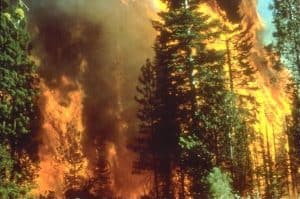“The Uninhabitable Earth” explains how climate change is much worse than you think
“We declare, with more than 11,000 scientist signatories from around the world, clearly and unequivocally, that planet Earth is facing a climate emergency.” These were the dire opening words of a report published November 4 in the journal BioScience. The declaration comes just two years after 15,000 scientists from 184 countries issued a similar warning to humanity.
Now, as I sit down to write this column, one of the biggest international news stories is the cataclysmic wildfires ravaging eastern Australia. Coming on the heels of another bad wildfire season in California, scientists have long warned that the hotter, drier conditions brought about by climate change would make fires more frequent and more intense.
Right outside my window, another climate story is taking place. Much of North America is in the grips of unprecedented November cold and snow. Although it may seem counterintuitive, there is also more and more evidence that a quickly warming arctic is actually the culprit.
The Uninhabitable Earth
Having just read “The Uninhabitable Earth” by American journalist David Wallace-Wells, the climate calamities we hear about almost everyday now are not surprising. On every harrowing page, the author makes it abundantly clear climate change is the all-encompassing story of our time and that humanity is well on the way to destroying our planet.
Wallace-Wells was motivated to write the book because of what he was seeing and hearing in the media – or rather not seeing and hearing. There was little sense of how alarming the climate science truly is. He saw that people accept the reality of climate change but are not really engaged. For a plethora of reasons, so many of us continue to live “in a state of half-ignorance and half-indifference”. This led to two years of research in which he read hundreds of scientific studies and met with dozens of scientists. In a recent interview, Wallace-Wells said, “I could count on one hand the number of studies I’ve seen that show an optimistic view of our climate future.”
Our frail response to date is not surprising. We have countless cognitive biases that make acting difficult, including an innate sense of optimism about the future. We look outside, and all still seems fine. Living in New York City, Wallace-Wells himself used to think he lived outside of nature. But science is telling us with ever-increasing urgency that we can’t look at the future based on the way most of the world is today. A potential hellscape is coming, and the science which proves it is rock solid.
Climate change is happening now and promises to get much, much worse. As the defining issue of the 21st century, it will impact every aspect of our lives, no matter how rich we are or where we live. Tragically, we have barely started to think about it in any meaningful way.
We used to think – most scientists included – that the scarier impacts would only occur in the distant future. Forget that. Wallace-Wells explains that we are already living on what is essentially a different planet. At our present 1.1 C degrees of warming above pre-industrial times, the climate is hotter than at any point since humans began walking the Earth. The author makes it abundantly clear that a climate crisis of unprecedented speed, scope, and severity is unfolding before our very – albeit still somewhat closed – eyes.
Speed
Although day-to-day change is difficult to perceive, the story of climate change is one of unparalleled speed. By one estimate, the climate is changing ten times faster than at any point in 66 million years. What is even more extraordinary, about half the greenhouse gases responsible for the crisis have been emitted in only the past 30 years. In other words, since 1989, the year in which “Seinfeld” began and the Intergovernmental Panel on Climate Change (IPCC) was created. In this short time, we have gone from a mostly stable climate to one of quickly-approaching chaos. As the IPCC reported a year ago, we now have 30 years to bring emissions to zero if we’re to avoid truly catastrophic impacts. This 1989 to 2050 timeframe is less than the span of an average human life.
However, emissions nearly everywhere in the world are still increasing. This is putting us on track to pass 1.5 C degrees of warming by 2040. One-and-a-half degrees is the threshold to avoid at all costs, according to the IPCC. As much as the 2015 Paris Agreement was a triumph of global cooperation, almost no country in the world is on track to meet its commitments. Canada included. Even if the Paris targets were met, the planet would still warm by 3 C. Still more depressing, we probably cannot avoid even 2 C of warming, no matter what we do, based on the tools and technologies that are presently available.
Already, the Greenland ice sheet could reach a tipping point of irreversible melting at just another 0.1 C degrees of warming. One billion people around the world are presently at risk for heat stress, including workers in the sugarcane region of El Salvador where as much as one-quarter of the men have chronic kidney disease.
Wallace-Wells points out that there are multiple layers of uncertainty when it come to predicting future outcomes. We don’t know, for example, how aggressively humanity will act – or when. Nor do we fully understand the effects of feedback loops. Already, permafrost in the rapidly warming Arctic is melting. Permafrost contains twice as much carbon as is currently suspended in the earth’s atmosphere. Much of it may evaporate as methane, which is 34 times as powerful as carbon dioxide as a greenhouse gas. There are other feedback loops, too, such as forest dieback. Dying trees strip the planet’s natural ability to absorb carbon, which causes still hotter temperatures and more dieback.
We should also keep in mind that nearly all climate change predictions have proven to be too conservative. In an article from November 10 in the New York Times, Eugene Linden points out that scientists have consistently low-balled their assessments of the consequences and time-lines of the greenhouse gases we continue to emit. Because of a perceived need for consensus, scientists have tended to underestimate both the severity and rapidity of threats. The same can be said for the predictions of economists.
Scope and severity
Climate change will be all-encompassing, shaping and distorting nearly every aspect of human life as it is lived today. The litany of impacts is almost too lengthy to fathom. Suffice it to say that climate change will adversely affect everything else we worry about, be it economic growth, food security, war, crime, gender equality, physical and mental health, plagues, drinking water, refugee emergencies, species loss, and much, much more. It will also transform our politics (a hint of which we saw in the federal election), our culture, and our sense of history as a march towards an increasingly better world. It will also be happening everywhere. Although climate change will impact some people on the planet much more intensely than others – especially the global south and countries like India – it will be inescapable.
Climate change is on course to eliminate economic growth. Should we do nothing, there will be a 30 percent or more decline in global GDP by 2100. By the end of the century, worldwide grain production could fall by half. However, the world may have twice as many people. By 2050, the expected heat and humidity will make hundreds of cities in Asia uninhabitable in summer. We will also be on course for dealing with 200 million climate refugees. Just two degrees of warming will mean irreversible ice melt, which would eventually flood Miami, Dhaka, Shanghai, Hong Kong and a hundred other cities around the world. And let’s not forget cost. A seawall to protect New York City alone would cost tens of billions of dollars and take 30 years to build.
The impacts on the oceans and ice sheets were further highlighted in a IPCC report released this past September. It explains how melting glaciers will affect the drinking water supply of countless millions, how marine heatwaves will drastically reduce the productivity of fisheries, and how a huge increase in marine pathogens will contaminate seafood.
What about alarmism?
Not surprisingly, David Wallace-Wells receives pushback for being too alarming. That being said, the book has received almost no criticism from the scientific community. When the author looks out at society, he sees far more people who are still too complacent about climate change than people who are at risk of falling into fatalism and despair. He believes that alarmism is of great value. He looks at how much momentum there has been over the last year, with much more alarmist rhetoric circulating about climate change in the aftermath of last October’s IPCC report. These include the world-wide climate strikes initiated by Greta Thunberg and the rise of the Extinction Rebellion movement in the U.K. In a recent interview, he explained how “all of these are unprecedented climate protest movements, and all of them are very, very explicit about the need to panic immediately.” Nor should we forget that alarmism helped us win World War Two, stop the use of DDT, radically curtail tobacco use and drunk driving.
The lasting message of this book is that there is lots to be terrified by. But just how bad things get will be totally up to us. The future is not yet written. What is certain, however, is that the solutions will be political – not individual action. More about this next week.

